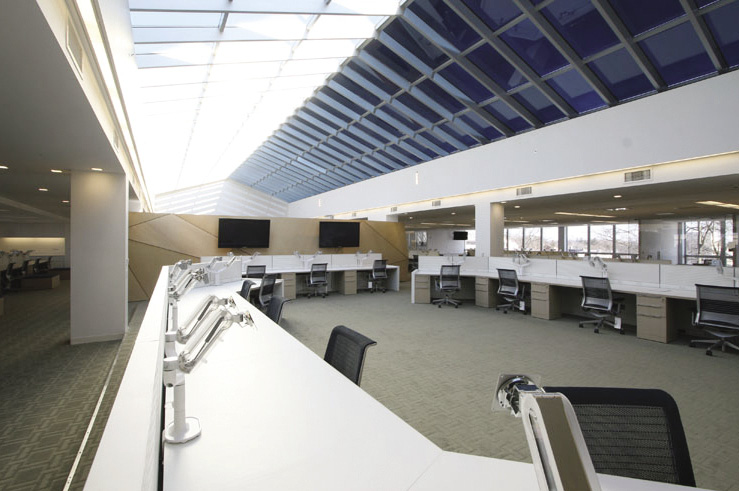Every summer for more than 10 years, a big, blue tarp would be draped over the top-floor skylight at 100 West Putnam. This summer, the tarp and aging skylight have been replaced with a responsive, photovoltaic powered system featuring SageGlass products.
A 14-inch photovoltaic strip also was installed on the exterior along the bottom of the skylight to power the glass, while remaining invisible to the people inside. Fabricated by Suntech Power Holdings Co., Ltd., this PV strip captures and converts solar energy that allows the SageGlass lites to provide a constant intermediate state of tinting, allowing a range of 3.5% to 62% visible light into the building. Acurlite Structural Skylights, Inc. was responsible for the removal, fabrication and installation.
"Every May up until now, the building owner would cover one of the best features of the space, blocking the unwanted solar heat and glare so the tenants wouldn't roast and could see their computer screens. This helped save a little on the air conditioning bills, but they lost all the natural light and views," said Gilbert Ohls, president of Landis Hall, Inc., a construction management company based in Greenwich, Conn.
The project team included a+i Architecture, pc of N.Y., Acurlite Structural Skylights, Inc. of Berwick. Pa.; with Skylight Consultants of America, Inc. of Martinsville, Ind., Suntech Power Holdings Co., Ltd. of Wuxi, China and SAGE Electrochromics, Inc. of Faribault, Minn.
As the new tenants of 100 West Putnam's top-floor office, Duff Capital Advisors hired Landis Hall to create a working environment that maintained the intended benefits of the skylight. "People feel better and are more productive when they have natural light. We want to get the most out of people and still have fun," said Phil Duff of Duff Capital. "It's a brain-power-driven business and we need to facilitate collaboration. We have trading turrets with multiple computer screens and people directly under the skylight. It's wonderful to have the natural light, but not if you can't read your screen because of the glare or if you can't control the solar radiant heat in summer."
Ohls said, "Our charge was to preserve the natural light any way that we could and make sure the skylight remained the focal point. They wanted the space to be energy-efficient and green, but also aesthetically pleasing. We also had to make sure it was functional to work under; visual and thermal comfort came first. You don't want it too intense and you don't want to feel like you're working in a cave."
In his search for an answer, Ohls arrived at four possible options that would, "keep the natural light, yet enable the tenant to have some control." These included an interior shading system, an interior louver system, permanent glass tinting, and SAGE's electronically tinting glass. "The problem with anything other than SageGlass technology was that those other options detracted from the best feature of the space," said Ohls. "Shades and louvered equipment would cloud it up and block the view. Permanent tinting could not be peeled off during different times of the day or year, based on the weather. SAGE's system gives us the ultimate flexibility, while staying energy-efficient and meeting our tight timeframe."
Duff said, "SAGE was the best solution. In comparison, everything else looked ugly or defeated the purpose. SAGE's glass offered a clean look, adjustable control and durability."
"When Gil contacted us, it was obvious he'd done his research. He already knew that we could provide a glass product that allowed Duff Capital to enjoy the sun's benefits, while rejecting its undesirable effects such as fading, glare, and excessive heat -- all without losing the view and connection to the outdoors," said John Van Dine, president of SAGE Electrochromics, Inc. "He also was excited to learn that we had been perfecting enhancements that include systems to control the glass at intermediate levels of tinting and to power the units with solar energy."
Van Dine said that because of their low DC voltage and power consumption, and the complementary relationship between the amount of sunlight available and the level of tinting required to modulate it, SageGlass products are excellent candidates for PV power.
In addition to providing the intermediate tinted states, the skylight for 100 West Putnam is wired with override switches to control SageGlass product's maximum and minimal tinted appearance. These control areas are grouped into eight zones corresponding with the tenant's trading floor, workstations, lounge, kitchen, and boardroom.
The buildings tenants gained this operability, and unprecedented access to the outdoors, late last year. The original skylight (circa 1986) and its accompanying blue tarp were removed in the fall, and by the end of 2008, the 85Hx35H ft. skylight array was installed. Contributing to the project's environmental leadership, the skylight's aluminum framing system contains approximately 64% recycled content. Linetec finished this material with a durable paint on the interior and an eco-friendly clear anodized on the exterior.
Tags:







